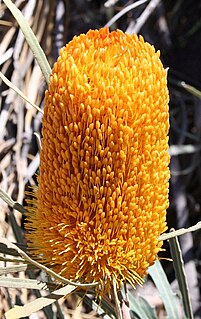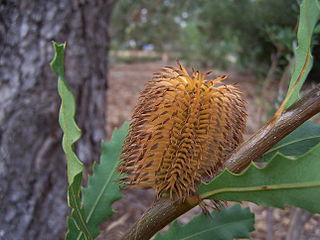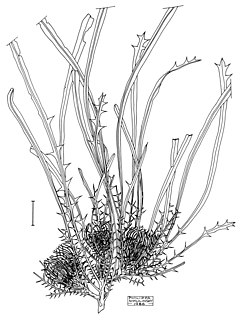
Banksia ashbyi, commonly known as Ashby's banksia, is a species of shrub or small tree that is endemic to Western Australia. It has smooth, grey bark, deeply serrated, hairy leaves and spikes of bright orange flowers.

Banksia baueri, commonly known as the woolly banksia, is a species of shrub that is endemic to the southwest of Western Australia. It has serrated leaves and a distinctively large and hairy looking inflorescence with cream, yellow or brown flowers, and hairy fruit.

Banksia baxteri, commonly known as Baxter's banksia or bird's nest banksia, is a species of shrub that is endemic to Western Australia. It has greyish brown bark, hairy stems, deeply serrated leaves with triangular lobes and lemon-yellow flowers in an oval flower spike that grows on the end of branches.

Banksia benthamiana is a species of shrub that is endemic to the south-west of Western Australia. It has hairy, linear leaves, usually with scattered small teeth along the edges, and spikes of orange flowers.

Banksia candolleana, commonly known as the propeller banksia, is a species of shrub that is endemic to Western Australia. It has shiny green, deeply serrated leaves with triangular lobes and spikes of golden yellow flowers on short side branches.

Banksia conferta, commonly known as the glasshouse banksia, is a species of shrub that is endemic to eastern Australia. It has rough, bark on the trunk, elliptic to egg-shaped leaves arranged in whorls, crowded yellow flowers in a cylindrical spike later forming a relatively large number of follicles.

Banksia gardneri, commonly known as prostrate banksia, is a species of prostrate shrub that is endemic to Western Australia. It has pinnatipartite or serrated leaves, usually rusty brown flowers, and up to twenty-five elliptical follicles in each fruiting head. It occurs along the west part of the south coast of the state.

Banksia occidentalis, commonly known as the red swamp banksia, is a species of shrub or small tree that is endemic to the south coast of Western Australia. It has smooth bark, linear, sparsely serrated leaves, golden flowers in a cylindrical spike, and later up to sixty follicles in each spike.

Banksia oreophila, commonly known as the western mountain banksia or mountain banksia, is a species of shrub that is endemic to the south-west of Western Australia. It has glabrous stems, wedge-shaped or narrow egg-shaped leaves with the narrower end towards the base, cylindrical spikes of pale pink to mauve flowers and later, up to twenty follicles in each spike, surrounded by the remains of the flowers. It occurs on slopes and hilltops in the Stirling and Barren Ranges.

Banksia ornata, commonly known as desert banksia, is a species of shrub that is endemic to south-eastern continental Australia. The Ngarrindjeri people of the Lower Murray region in South Australia know it as yelakut. It has thin bark, serrated, narrow egg-shaped leaves with the lower end towards the base, cream-coloured flowers in a cylindrical spike, and later, up to fifty follicles in each spike, surrounded by the remains of the flowers.

Banksia pilostylis is a species of shrub that is endemic to the south-west of Western Australia. It has hard, fissured bark, narrow wedge-shaped, serrated leaves, pale yellow flowers in cylindrical spikes and elliptical follicles that open when heated in a bushfire.

Banksia quercifolia, commonly known as the oak-leaved banksia, is a species of shrub that is endemic to the southwestern coast of Western Australia. It has smooth, greenish bark, wavy, wedge-shaped, serrated leaves, yellow, orange or brown flowers in cylindrical spikes, followed by broadly linear follicles surrounded by the remains of the flowers.

Banksia penicillata is a species of shrub that is endemic to a restricted area of New South Wales. It has smooth bark, serrated, elliptic to egg-shaped leaves, green to bluish flower buds, later yellow flowers in a cylindrical spike, and later still, up to one hundred narrow elliptical follicles in each spike, surrounded by the remains of the flowers.

Banksia armata, commonly known as prickly dryandra, is a species of often sprawling shrub that is endemic to Western Australia. It has deeply serrated leaves with sharply pointed lobes and spikes of about 45 to 70 yellow flowers.
Banksia biterax is a species of dense shrub that is endemic to Western Australia. It has hairy stems, deeply serrated leaves and spikes of up to 200 pale to dark brown flowers.

Banksia falcata, commonly known as prickly dryandra, is a species of prickly, column-shaped shrub that is endemic to Western Australia. It has serrated or pinnatipartite leaves, heads of up to 150 yellow flowers and soft-hairy fruit.
Banksia glaucifolia is a species of shrub that is endemic to Western Australia. It has deeply serrated, wedge-shaped leaves with sharply pointed lobes, pale yellow flowers and follicles with hairy edges.

Banksia hirta is a species of shrub that is endemic to Western Australia. It has hairy stems, deeply serrated leaves, pale yellow flowers in heads of about one hundred and shining follicles. It is restricted to the Stirling Range National Park.

Banksia heliantha, commonly known as oak-leaved dryandra, is a species of shrub that is endemic to Western Australia. It has hairy stems, serrated, egg-shaped to wedge-shaped leaves, golden yellow flowers and partly woolly follicles.

Banksia subpinnatifida is a species of bushy shrub that is endemic to the southwest of Western Australia. It has more or less linear, pinnatipartite leaves with sharply-pointed teeth on the sides, golden yellow flowers in heads of about sixty, and glabrous, elliptical follicles.



















